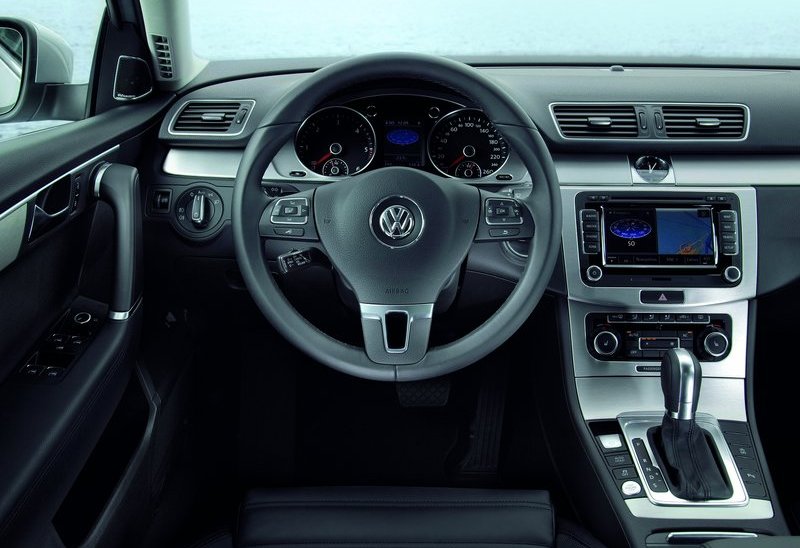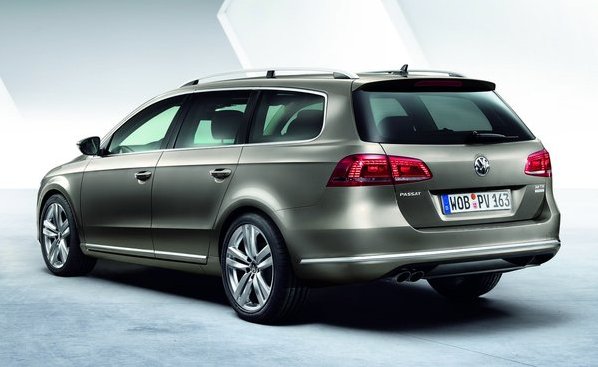The most striking design element of the new Passat, Volkswagen calls the seventh generation of the model in its press release, is a front resculpted very similar to the flagship of the German car manufacturer Volkswagen Phaeton luxury sedan.
2011 Volkswagen Passat Estate
2011 Volkswagen Passat Estate
 The Volkswagen Passat represents one of the very great success stories in automotive history, with over 15 million cars sold since the VW Passat was first launched in 1973. It is now available in over 100 countries across the globe. At the 2010 Mondial de l'Automobile in Paris (October 2-17), Volkswagen is presenting the world premiere of an entirely new Passat - as a saloon and an estate car simultaneously. The seventh generation of this bestseller will be available in initial European markets starting as soon as mid-November.
The Volkswagen Passat represents one of the very great success stories in automotive history, with over 15 million cars sold since the VW Passat was first launched in 1973. It is now available in over 100 countries across the globe. At the 2010 Mondial de l'Automobile in Paris (October 2-17), Volkswagen is presenting the world premiere of an entirely new Passat - as a saloon and an estate car simultaneously. The seventh generation of this bestseller will be available in initial European markets starting as soon as mid-November.The third vehicle that will be presented by VW in Geneva is the Volkswagen Passat Estate TSI EcoFuel. The Volkswagen Passat Estate TSI EcoFuel is powered by a TSI direct-injection turbo engine that develops 110-kW / 150-PS and only needs 5.2 kilograms of gas per 100 kilometers.
2011 Volkswagen Passat Estate
 Typical for VW, the new Passat is offered to a range of 10 different engines ranging in power from 105 hp (77 kW) to 300 hp (220 kW). The entry-level diesel, the 1.6 TDI delivers 105 hp and 250 Nm of reduced fuel consumption, now with a rating of 4.2 l/100 km and CO2 emissions of 109 g / km, with the stop / start system for diesel to standard in all trim levels.
Typical for VW, the new Passat is offered to a range of 10 different engines ranging in power from 105 hp (77 kW) to 300 hp (220 kW). The entry-level diesel, the 1.6 TDI delivers 105 hp and 250 Nm of reduced fuel consumption, now with a rating of 4.2 l/100 km and CO2 emissions of 109 g / km, with the stop / start system for diesel to standard in all trim levels.The eco-numbers are also competitive, if not the benchmark in its class at the Otto-side, with the 1.4 TSI with 122 PS (90 kW) with BlueMotion technology (including a start-stop system) Figure 5, 8 l / 100 km and a CO2 value of 138 g / km.
The Passat will feature the same three trim levels – Trendline, Comfortline and Highline. New equipment demand in the model, the Dynamic Light Assist, first in the new Touareg introduced which tells about the use of high beam for better road, while avoiding glare of oncoming drivers by using a smart camera, the lighting set the direction of light .
Also new is the electronic differential lock transversal XDS – having first appeared on the Golf GTI – the improved traction when cornering with.
2011 Volkswagen Passat Estate

From Volkswagen Press Release:
The Passat Estate TSI EcoFuel being premiered in Geneva marks the beginning of a new era for natural-gas-fuelled automobiles. Until now, passenger cars operated using eco-friendly, low-consumption natural gas have tended to be "mild mannered". The Passat changes that once and for all with its 110-kW / 150-PS TSI engines. And yet the direct-injection turbo engine in the Passat,specifically designed to run on natural gas, consumes no more than 5.2 kilograms of gas per 100 kilometers. The Passat and the Passat Estate TSI EcoFuel are due to be launched on the market around year-end.
Efficiency: Engines & Gearboxes
Volkswagen is offering a selection of ten direct-injection engines with four valves per cylinder in the new Passat. Four of them are classic high-tech petrol engines that output 90 kW / 122 PS (1.4 TSI), 118 kW / 160 PS (1.8 TSI), 155 kW / 211 PS (2.0 TSI) and 220 kW / 300 PS (V6). The top engine has six cylinders; all of the other petrol engines are charged four-cylinder engines. Also charged is the 110 kW / 150 PS engine (1.4 EcoFuel) that is configured for natural gas. Another derivative of the 1.4 TSI is the MultiFuel engine with 118 kW / 160 PS designed for use with up to 85 percent ethanol fuel.
Four turbodiesel engines are being offered with three power outputs; the four-cylinder engines produce 77 kW / 105 PS (1.6 TDI), 103 kW / 140 PS (2.0 TDI and 2.0 BlueTDI) as well as 125 kW / 170 PS (2.0 TDI). With the exception of the 105 PS TDI, any of the engines of the new VW Passat may be combined with a dual-clutch gearbox (DSG); with the 3.6 V6, this automatic gearbox is standard.
Petrol - three four-cylinder TSIs and one V6: Fuel consumption values are impressive. Setting the pace among the petrol engines is the Volkswagen Passat 1.4 TSI with optional BlueMotion Technology. It outputs 90 kW / 122 PS and consumes 5.8 l/100 km (equivalent to 138 g/km CO2).
While the groundbreaking previous model exhibited a nearly identical low fuel consumption figure, fuel economy improvements in the more powerful engines are even more dramatic. Consider the Passat 1.8 TSI with 118 PS: Here the development team reduced the engine's combined fuel consumption from 7.4 to 6.9 l/100 km; this resulted in a CO2 value of 160 g/km. No less significant is the reduced fuel consumption of the powerful TSI, now 211 PS instead of 200 PS; it has a combined fuel consumption of 7.2 l/100, which is 0.6 litre less than on the previous model. Accordingly, CO2 emissions were reduced from 183 to 169 g/km. The combined fuel consumption of the top version - the Volkswagen Passat V6 with 300 PS and all-wheel drive - also fell to 9.2 l/100 km (previously 9.8 litres). The new CO2 emissions value is 215 g/km.
Natural gas - the EcoFuel engine: One of the lowest emitting models of the medium class is the VW Passat EcoFuel; in the new version, a combined fuel consumption value of 6.6 m3 natural gas per 100 km was measured; this has equivalent CO2 emissions of just 117 g/km, and fuel consumption was reduced by 0.4 m3. Thanks to twincharging by turbo- and supercharger (twincharger), the Passat EcoFuel is one of the top-performing natural gas vehicles in the world.
Ethanol - the MultiFuel engine: Specially developed for use in Sweden and Norway, and based on the twincharged 1.4 TSI, is the 118 kW / 160 PS MultiFuel Twincharger. This engine in the programme can be powered by petrol fuel with up to 85 percent ethanol content.
Diesel - four TDI engines: The most fuel-efficient version of the new Volkswagen Passat is the 1.6 TDI BlueMotion with 105 PS. In the previous version, this engine already delivered impressively low fuel consumption values. Measures introduced to enhance aerodynamics, further internal engine refinements and technologies such as the Stop/Start system and battery regeneration have reduced fuel consumption to 4.2 l/100 km in the new Passat BlueMotion (saloon); this is equivalent to a CO2 value of 109 g/km. By comparison: on the previous model, the figures were 4.4 litres and 114 g/km. Fuel consumption was also reduced in the 140 PS VW Passat 2.0 TDI BlueMotion Technology; 4.5 litres (119 g/km CO2) nearly matches the values of the 105 PS BlueMotion model of the previous VW Passat generation.
Extreme progress was made on the Volkswagen Passat 2.0 BlueTDI and the Passat 2.0 TDI with 170 PS. For the particularly low-emitting Passat 2.0 BlueTDI (Euro 6 emissions standard) with SCR catalytic converter and 140 PS (previously 143 PS), fuel consumption was reduced by 0.6 l/100 km to just 4.6 litres (122 g/km CO2). The combined fuel consumption of the 170 PS Passat 2.0 TDI is 4.7 l/100 km (123 g/km) - 0.9 litre less than on the previous model. Values for the Volkswagen Passat Estate - and this applies to all engine options - are at about the same level - and superior to the


No comments:
Post a Comment